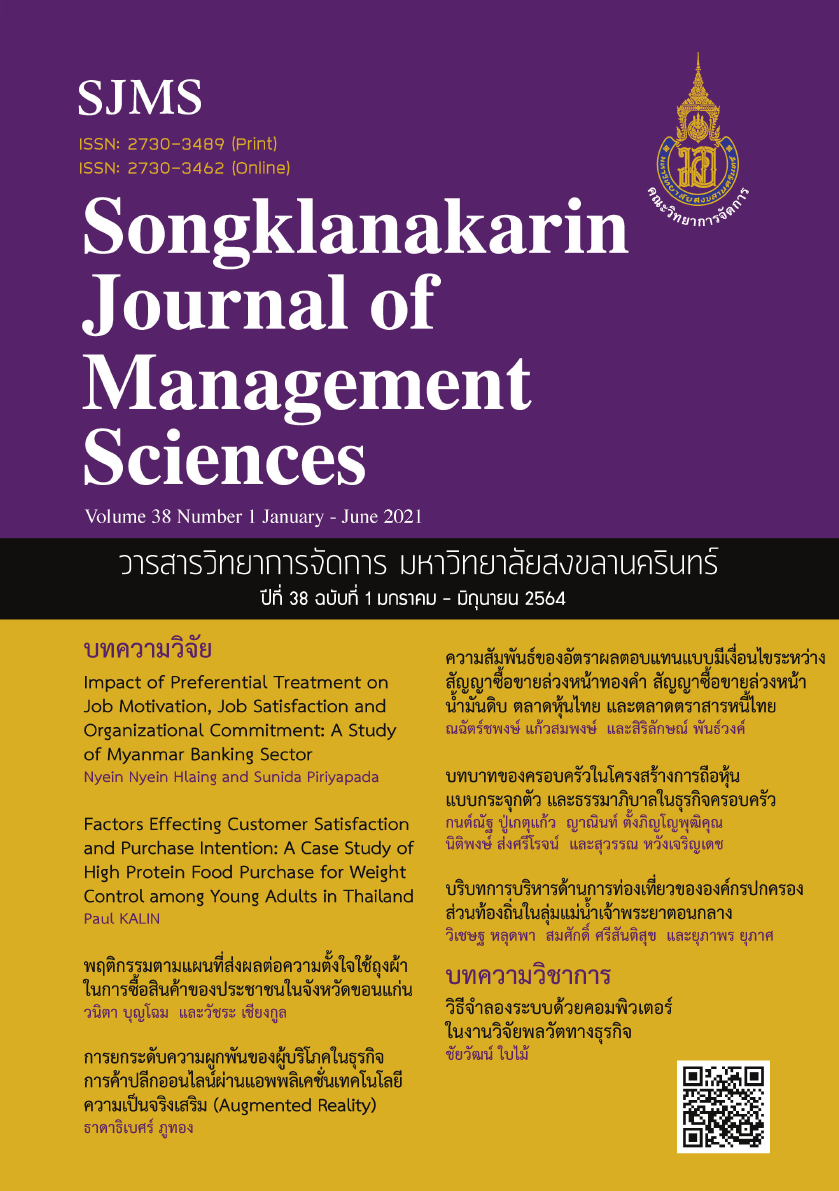วิธีจำลองระบบด้วยคอมพิวเตอร์ในงานวิจัยพลวัตทางธุรกิจ
Main Article Content
บทคัดย่อ
การจัดการธุรกิจในปัจจุบันเผชิญกับปัญหาหลักเกี่ยวกับสภาพแวดล้อมที่ซับซ้อนมากขึ้น ในมุมมองทางวิชาการ การทำความเข้าใจความซับซ้อนเช่นนี้ยังไม่พัฒนาไปเท่าที่ควร ส่วนหนึ่งเนื่องมาจากข้อจำกัดของวิธีวิจัยแบบดั้งเดิมที่นิยมใช้กันโดยทั่วไป เช่น โมเดลแสดงความสัมพันธ์ และโมเดลสมการโครงสร้าง บทความนี้นำเสนอเทคนิคที่ได้พัฒนามายาวนานแล้วในสายวิทยาศาสตร์ คือ วิธีจำลองระบบด้วยคอมพิวเตอร์ ให้เป็นทางเลือกหนึ่งเพื่อใช้ในงานวิจัยพลวัตทางธุรกิจ ข้อได้เปรียบหลักของการจำลองระบบ คือ ปฏิสัมพันธ์ระหว่างองค์กรและสภาพแวดล้อมในการดำเนินธุรกิจสามารถจำลองออกมาเป็นตัวแบบที่ชัดเจน ดังนั้น การจำลองระบบจึงสามารถช่วยในการทำความเข้าใจปรากฏการณ์ที่ซับซ้อนและเป็นพลวัต เช่น การเปลี่ยนแปลงอย่างฉับพลัน อย่างไรก็ตาม แม้ว่าวิธีการนี้จะนิยมใช้ในศาสตร์หลายด้าน แต่งานวิจัยพลวัตทางธุรกิจที่ใช้เทคนิคเช่นนี้ไม่แพร่หลายมากนัก ส่วนหนึ่งเป็นเพราะยังขาดแคลนการรวบรวมความรู้ในเนื้อหาดังกล่าวอย่างเป็นระบบ ดังนั้น บทความนี้จึงมีวัตถุประสงค์หลักเพื่อการเติมเต็มองค์ความรู้ที่ขาดหายไป และสนับสนุนให้ใช้ประโยชน์จากข้อได้เปรียบของการจำลองระบบกับงานวิจัยพลวัตทางธุรกิจ โดยใช้คอมพิวเตอร์เป็นตัวหลักในขั้นตอนของวิธีดำเนินการวิจัย
Article Details

อนุญาตภายใต้เงื่อนไข Creative Commons Attribution-NonCommercial-NoDerivatives 4.0 International License.
บทความที่ตีพิมพ์ถือเป็นลิขสิทธิ์ของวารสารวิทยาการจัดการ มหาวิทยาลัยสงขลานครินทร์ อย่างไรก็ตาม กองบรรณาธิการไม่สงวนลิขสิทธิ์ในการทำซ้ำ คัดลอก หรือเผยแพร่ แต่จะต้องอ้างอิงให้ถูกต้องตามหลักวิชาการ
เอกสารอ้างอิง
Asawaphum, S. (2016). Systematic theory thinking and educational administration. Buabandit Journal of Educational Administration, 16(2), 1-12.
Baril, C., Gascon, V., Miller, J., & Cote, N. (2016). Use of a discrete-event simulation in a Kaizen event: a case study in healthcare. European Journal of Operational Research, 249(1), 327-339.
Bertalanffy, L. (1968). General system theory: foundations, development, applications. New York: George Braziller.
Bollen, K., & Long, S. (1993). Testing structural equation models. Newbury Park, California: Sage Publications.
Cannon, W. (1929). Organization for physiological homeostasis. Physiological Reviews, 9(3), 399-431.
Capaldo, A., & Giannoccaro, I. (2015). Interdependence and network-level trust in supply chain networks: a computational study. Industrial Marketing Management 44(1), 180-195.
Chan, N., & Wong, H. (2006). Simulation techniques in financial risk management. New Jersey: Wiley.
Chandler, G., DeTienne, D., McKelvie, A., & Mumford, T. (2011). Causation and effectuation processes: a validation study. Journal of Business Venturing, 26(3), 375-390.
Csaszar, F. (2018). A note on how NK landscapes work. Journal of Organization Design, 7(15), 1-6. Retrieved January 9, 2019, from https://doi.org/10.1186/s41469-018-0039-0
Davis, J., Eisenhardt, K., & Bingham, C. (2007). Complexity theory, market dynamism, and the strategy of simple rules. Working paper, Stanford Technology Ventures Program, Stanford, CA: Stanford University.
Demil, B., & Lecocq, X. (2010). Business model evolution: in search of dynamic consistency. Long Range Planning, 43(2), 227-246.
Ganco, M., & Agarwal, R. (2009). Performance differentials between diversifying entrants and entrepreneurial start-ups: a complexity approach. Academy of Management Review, 34(2), 228-252.
Ganco, M., & Hoetker, G. (2009). NK modeling methodology in the strategy literature: bounded search on a rugged landscape, in Donald D. Bergh, David J. Ketchen (ed.) Research Methodology in Strategy and Management (Volume 5), Emerald Group Publishing Limited, 237-268.
Hair, J., Hult, G., Ringle, C., & Sarstedt, M. (2016). A primer on partial least squares structural equation modeling. Thousand Oaks, CA: Sage Publications.
Hannan, M., & Freeman, J. (1977). The population ecology of organizations. American Journal of Sociology, 82(5), 929-964.
Heizer, J., Render, B., & Munson, C. (2017). Operations management: sustainability and supply chain management (12th ed.). Essex, UK: Pearson Education.
Henderson, L. (1913). The fitness of the environment: an inquiry into the biological significance of the properties of matter. New York: Macmillan.
Jain, A., & Kogut, B. (2014). Memory and organizational evolvability in a neutral landscape. Organization Science, 25(2), 479-493.
Kauffman, S. (1987). Towards a general theory of adaptive walks on rugged landscapes. Journal of Theoretical Biology, 128(1), 11-45.
Kauffman, S. (1993). The origins of order: self-organization and selection in evolution. Oxford: Oxford University Press.
Kauffman, S. (1995). At home in the universe. Oxford: Oxford University Press.
Keyhani, M., Lévesque, M., & Madhok, A. (2013). Toward a theory of entrepreneurial rents: a simulation of the market process. Strategic Management Journal, 36(1), 76-96.
Khraisha, T. (2020). Complex economic problems and fitness landscapes: assessment and methodological perspectives. Structural Change and Economic Dynamics, 52, 390-407.
Kirzner, I. (1973). Competition and entrepreneurship. Chicago, IL: The University of Chicago Press.
Kirzner, I. (1997). Entrepreneurial discovery and the competitive market process: an Austrian approach. Journal of Economic Literature, 35(1), 60-85.
Leenawong, N., & Maneechai, S. (2008). Mathematical model and simulation for multiple complex systems. University of the Thai Chamber of Commerce Journal, 28(1), 48-65.
Limphaibool, W., Chaisuwan, C., & Buranapin, S. (2019). A critical incident analysis from experiences of executives on organizational resilience. Chulalongkorn Business Review, 41(4), 87-114.
Levinthal, D. (1997). Adaptation on rugged landscapes. Management Science, 43(7), 934-950.
Lukhnovskii, I., & Golovko, M. (1980). Statistical theory of classical equilibrium systems. Moscow: Kiev, Izdatel'stvo Naukova Dumka.
Mae Fah Luang University. (2019). The evolution of production management. Retrieved January 11, 2020, from http://phalit-thai.tripod.com/boywww/eew/chapter1_2.htm
Pepper, S. (1972). Systems philosophy as a world hypothesis. Philosophy and Phenomenological Research, 32(4), 548-553.
Rahmandad, H., & Sterman, J. (2012). Reporting guidelines for simulation-based research in social sciences. System Dynamics Review, 28(4), 396-411.
Rivkin, J. (2001). Reproducing knowledge: replication without imitation at moderate complexity. Organization Science, 12(3), 274-293.
Roundy, P., Bradshaw, M., & Brockman, B. (2018). The emergence of entrepreneurial ecosystems: a complex adaptive systems approach. Journal of Business Research, 86, 1-10.
Santhitiwanich, A. (2014). Epistemological status of social science. Kasetsart Journal of Social Sciences, 35(3), 472-487.
Sarasvathy, S. (2001). Causation and effectuation: toward a theoretical shift from economic inevitability to entrepreneurial contingency. Academy of Management Review, 26(2), 243-263.
Sastry, M. (1997). Problems and paradoxes in a model of punctuated organizational change. Administrative Science Quarterly, 42(2), 237-275.
Schumpeter, J. (1934). The theory of economic development. New York: Oxford University Press.
Solow, D., Burnetas, A., Tsai, M., & Greenspan, N. (1999). Understanding and attenuating the complexity catastrophe in Kaufman’s NK model of genome evolution. Complexity, 5(1), 1-21.
Solow, D., Vairaktarakis, G., Piderit, S., & Tsai, M. (2002). Managerial insights into the effects of interactions among members of a team. Management Science, 48(8), 1060-1073.
Waehama, W. (2018). Comparison of the effectiveness of work integrated learning and computer simulation teaching method for theoretical subjects in hospitality industry curriculum. Journal of Management Sciences, 35(1), 51-74.
Welter, C., & Kim, S. (2018). Effectuation under risk and uncertainty. Journal of Business Venturing, 33(1), 100-116.
Yanpiboon, T., Popaitoon, S., & Songsrirote, N. (2019). Network ties, entrepreneurial orientation, and innovation of new firms in Thai agricultural business sector. Journal of Business Administration, 42(164), 44-60.

